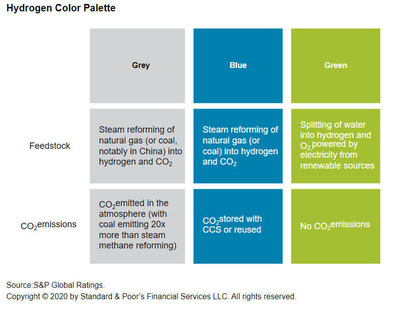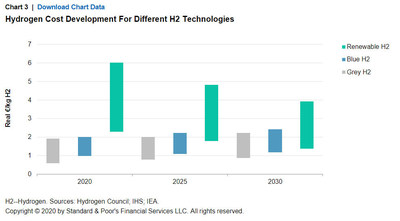Press Releases
PARIS, Nov. 23, 2020 In a report published today, "How Hydrogen Can Fuel The Energy Transition," S&P Global Ratings says it believes hydrogen can push the energy transition forward, but this would require coordinated policy, lower hydrogen production costs, and massive growth of renewables. Hydrogen has so far occupied a niche in the refining, chemicals, and ammonia fertilizer sectors since it is more expensive than conventional fuels: on an energy-equivalent basis, $2 per kilogram (/kg) of hydrogen equates to a gas price of $17.6 per million British thermal unit.
Governments' decarbonization policies and long-term emission targets are strengthening the case for low-carbon hydrogen, but the cost of producing it from renewables has to fall more than 50% to $2.0/kg-$2.5/kg by 2030 to make hydrogen a viable alternative. This may be attainable with solar or wind production costs of $20 per megawatt hour (/MWh) to $30/MWh, or lower, if capital spending on electrolyzers also declines by 30%-50% as plants are built at industrial scale.
"Ample availability of competitive renewable sources and simultaneous support for blue hydrogen (with CO2 capture and storage) are therefore prerequisites for hydrogen to take a more prominent position in the energy transition," said S&P Global Ratings credit analyst Massimo Schiavo. "A Hydrogen Council report suggests that hydrogen could account for 15% of global primary energy supply by 2050. Yet the huge cost of producing it is a potential stumbling block. It's more likely that hydrogen developments this decade will be for the production of commercial transport vehicles, assuming fuel-cell costs decline."
"A truly hydrogen-based economy, in which hydrogen, not gas, is used to heat buildings and balance the power grid, for example, therefore appears out of reach, at least before 2030. It would necessitate zero-carbon policies and renewables comprising at least 70%-80% of the power mix, considering that the most cost-efficient way to decarbonize is to replace coal- and gas-fired power with renewables," added S&P Global Ratings Head of Infrastructure Research Karl Nietvelt.
Related Research
- WEBCAST/SLIDES: The Energy Transition And COVID-19: A Pivotal Moment For Climate Policies And Energy Companies, Oct. 8, 2020
- SLIDES: The Energy Transition And COVID-19: A Pivotal Moment For Climate Policies And Energy Companies, Oct. 8, 2020
- The Energy Transition And COVID-19: A Pivotal Moment For Climate Policies And Energy Companies, Sept. 24, 2020
- The Energy Transition: The Effect Of COVID-19 Economic Recovery Policies, Sept. 24, 2020
- The Energy Transition: Does COVID-19 Bend The Emissions Curve To 2 Degrees?, Sept. 24, 2020
- The Energy Transition: COVID-19 And Peak Oil Demand, Sept. 24, 2020
- The Energy Transition: COVID-19 Undermines The Role Of Gas As A Bridge Fuel, Sept. 24, 2020
- The Energy Transition: COVID-19 Could Make 2020 Crucial For Renewables, Sept. 24, 2020
This report does not constitute a rating action.
S&P Global Ratings is the world's leading provider of independent credit ratings. Our ratings are essential to driving growth, providing transparency and helping educate market participants so they can make decisions with confidence. We have more than 1 million credit ratings outstanding on government, corporate, financial sector and structured finance entities and securities. We offer an independent view of the market built on a unique combination of broad perspective and local insight. We provide our opinions and research about relative credit risk; market participants gain independent information to help support the growth of transparent, liquid debt markets worldwide.
S&P Global Ratings is a division of S&P Global (NYSE: SPGI), which provides essential intelligence for individuals, companies and governments to make decisions with confidence. For more information, visit www.spglobal.com/ratings.
SOURCE S&P Global Ratings


